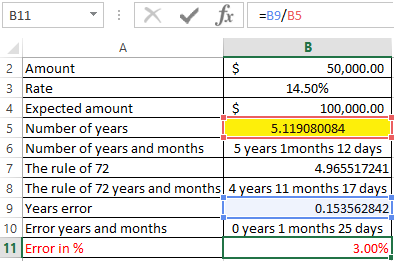
LN Function Overview The LN Function Calculates the natural logarithm of a number. To use the LN Excel Worksheet Function, select a cell and type: (Notice how the formula inputs appear). The natural logarithm function and exponential function are the inverse of each other, as you can see in the graph below: This inverse relationship can be represented with the formulas below, which the input to the LN function is the output of the EXP function: = LN(EXP(1)) // returns 1 = LN(EXP(2)) // returns 2 = LN(EXP( n )) // returns n. Jul 03, 2018 Similarly the syntax for natural log in Excel is =LN (value). In other words if we put a number x in A1 and in A2 we put the formula =LN (A1^2-1), this gives us ln(x2 − 1).
Understanding Log Return and Continuous Compounding

Intermediate
Log Return is one of three methods for calculating return and it assumes returns are compounded continuously rather than across sub-periods. It is calculated by taking the natural log of the ending value divided by the beginning value. (Using the LN on most calculators, or the =LN() function in Excel)
Synonyms: logarithmic return, continuously compounded return
For context, it's important to recall from high school math that the letter e is a constant value rounded to 2.71828. The unrounded number e can be found in Excel using =EXP(1).
Much like pi which describes the ratio of circumference to the diameter of all circles, e can be used to quantify all continuously compounding processes like inflation, interest rates, population growth and even radioactive decay.
For practicality in Finance however, banks don't pay interest on a continuously compounding basis, so keep that in mind.
How to Calculate Log Returns
As an example to find a continuously compounding rate of return, let's say the ending value of an investment was $11 and the beginning value was $10. The Excel function would read =LN(11/10) for a result of 9.53%.
To calculate a continuously compounded ending value on a $100 investment at 3% per year for 5 years would result in an ending value of $116.18, using the formula:
- Ending Value = Beginning Value * (e)^(rate * time)
- $116.18 = $100 * 2.71828^(0.03 * 5)
In math and statistics, a distinction is often made between discrete and continuous data. Log return is the more theoretical continuous version. In the practical world, however, most people think of returns broken into discrete periods instead.
- Arithmetic return - One period, not-compounded, discrete.
- Geometric return - Multi-period, compounded, discrete.
- Logarithmic return - Infinite-periods, compounded, continuous.

The corresponding ending value using non-compounded returns (arithmetic) would yield $115.00. If compounded five times (geometric) the ending value would be $115.93.

So log return is the non-discrete version, so continuous, meaning it answers what the ending value would be if the whole period was broken into an infinite number of sub-periods. See, it's theoretical.
Other than for very short periods of time (typically less than 1 day), and for theoretical applications involving calculus and precisely measuring curves and tests for the normality of investment return distributions, log returns are not as common as arithmetic and geometric returns.
In a Sentence
Tom: If log return compounds most frequently, why is the rate the lowest?
Doc: Chew on this. Let's say $1 grew to $1.10 in a year; the non-compounding return is 10%.
Video
Many terms have 4-5 minute videos showing a derivation and explanation. If this term had one, it would appear here.
Natural Log In Excel Vba
Videos can also be accessed from our YouTube Channel.
Video Script
If this term had a video, the script would be here.
Quiz
Click box for answer.
False. It is best suited for daily or hourly periods.
$2,013.75. The others represent arithmetic and geometric total returns, respectively. To confirm type =LN(2013.75/1000) in Excel to get 7%.
Questions or Comments?
Natural Log
Still unclear on log returns? Check out the tutorial page and video on Stock return calculation methods from the Quant 101 Series on YouTube. There we go over when to use arithmetic, geometric and log returns.

Related Terms
Inverse Of Natural Log In Excel
Our trained humans found other terms in the category return math you may find helpful.